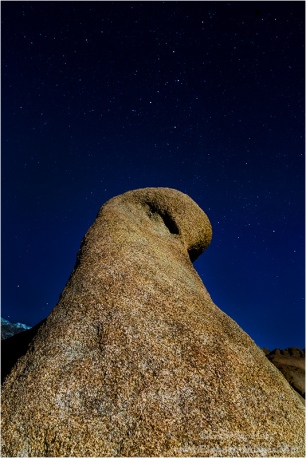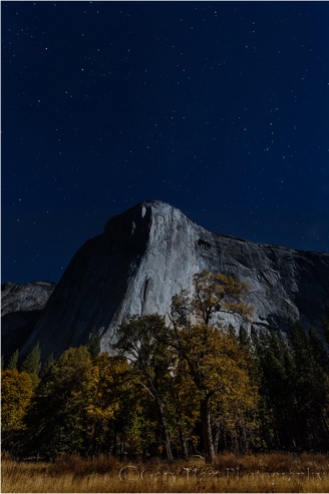Eloquent Images by Gary Hart
Insight, information, and inspiration for the inquisitive nature photographer
Moonlight

Big Dipper, Alabama Hills, California
Moonlight photography is both simple and rewarding. In my “Shoot the Moon” article that appeared in the April 2010 Outdoor Photographer magazine, I shared my exposure recipe and some simple tips to ensure moonlight success. This post summarizes and updates the moonlight insights from that article.
Equipment for moonlight photography
At the very least you need a tripod sturdy enough to support your camera and lens. And while some point-and-shoot cameras are capable of the necessary exposure settings, I highly recommend a mirrorless or DSLR camera for the exposure control it allows, its ease of use in difficult conditions, and (especially) the ability to perform in low light.
A wide, fast (-ish) lens works best, ideally at least as wide as 24mm and as fast as f4. To minimize camera shake, try to avoid extending the tripod’s center post, and use a remote (cable) release or your camera’s two- or ten-second timer.
Moonlight exposure
To fully illuminate your subjects and maximize the number of stars visible, the moon should be at your back, not in your frame. The starting exposure settings I recommend for full moon (full moon +/- a day or two) photography are:
- ISO 800
- f4
- 10 seconds
A full moon’s brightness varies with many factors (such as atmospheric particles or moisture, or the moon’s size), but these settings will get your exposure within a stop or so. When the exposure is complete, check your LCD and adjust the light up or down.
Slower shutter speeds and higher ISOs result in more light, but also more star movement (shutter speed) and more digital noise (ISO). A full moon is bright enough that there should be no need for exposures longer than 20 seconds; given the high ISO capabilities of today’s cameras, I don’t hesitate to use ISO 3200 (or even higher) before using a 20-second shutter speed that risks visible star motion. If you have a lens that’s faster than f4, use the larger aperture and drop your ISO or shutter speed by a corresponding amount.
There’s no absolute “best” exposure, so experiment with the exposure variables and decide later whether you like the slightly cleaner lower ISO image, or the more pinpoint stars of the faster shutter speed.
Composition for moonlight
Composition is subjective and ultimately up to the creative instincts of the photographer. Having said that, I can still offer some experience-based suggestions:
- It’s easier to identify potential moonlight locations and subjects in advance, in daylight, than it is to wander around in the dark.
- Look for light, reflective subjects like water or granite, or subjects with a strong outline that stands out against the sky, such as trees, or prominent rocks or mountains.
- Vertical compositions will give you more dark sky, and therefore more stars.
- Unless the foreground is spectacular, compose with the sky occupying at least 2/3 of the frame—a frequent mistake photographers make is not including enough sky, and it’s usually the stars that make night photography special.
- Try to include recognizable constellations, such as the Big Dipper, Orion, or Cassiopeia.
Focus in moonlight
By far the greatest difficultly people have photographing in moonlight is finding accurate focus. Accustomed to reliable daylight autofocus, they scratch their heads when everything seems to be set properly, yet their camera refuses respond when the shutter-button is pressed. The problem is, the camera is hunting in vain for focus because moonlight usually isn’t bright enough for autofocus. And since there is no fixed infinity point on a zoom lens (the infinity point varies with the focal length—trust me), the old prime lens trick of dialing the focus all the way out to infinity doesn’t work either.
Fortunately, all is not lost. Follow this multi-step process each time you adjust your focal length and all will be fine:
- On a tripod, compose your shot (or simply increase dial your focal length to maximum width)
- Without changing your focal length, remove the camera from the tripod and autofocus on the moon
- Return your camera to the tripod and switch the lens to manual focus (important!)—and remember, don’t adjust your focal length
- Shoot
- Check your focus by magnifying the resulting image on the LCD
The above method works best for DSLR cameras. On my Sony mirrorless bodies, I usually just magnify a bright star and manually focus until it’s the smallest dot possible. If you want to autofocus on the moon with a mirrorless camera, you’ll need to drop your shutter speed until you can see detail in the moon—otherwise the moon will be so bright that all focusable detail is lost.
I’ve said it once, but I’ll say it again: once you think you’ve achieved focus, magnify an image on your LCD to verify its sharpness. Once you’ve confirmed that you are indeed focused, there’s no need to verify again unless you change focal length or turn the focus ring (but I still check every half dozen or so frames, just to be sure I haven’t inadvertently changed my focus).
Processing moonlight images
I strongly encourage you to shoot moonlight in raw mode. A raw image increases your margin for error (it’s easier to correct mistakes in a raw image than in a jpeg image), and gives you total control over your light temperature (white balance).
Light temperature is important because straight from the camera, moonlight images tend to look like daylight with stars (too bright and warm). You can avoid this problem by exposing a little darker than daylight (the exposure settings I suggest above should result in a histogram skewed slightly to the left), and cooling the color temperature down to the 3,000-4,000 degree range in the raw processor. (If none of this processing stuff makes sense, ignore it and continue shooting in jpeg mode until you learn how to process raw images.) This will result in an image with a cooler (more blue) color cast that makes it look more night-like.

Mono Moonlight, South Tufa, Mono Lake
Workshop Schedule || Purchase Prints || Instagram
Moonlight



















Pingback: Moon over where-ever | Eloquent Nature by Gary Hart
Pingback: Moonbow: Nature’s little secret | Eloquent Nature by Gary Hart
Pingback: Seeing in the dark | Eloquent Nature by Gary Hart
Pingback: Ode to the Sony a7S | Eloquent Nature by Gary Hart
Nice. Thanks. Night time is the RIGHT time. I do mostly stars, moon, and long exposures. Not able to take workshops but enjoy your sharing. IG @jocksphotos
Pingback: Moonlight Magic | Eloquent Images by Gary Hart
Pingback: Natural Light Painting | Eloquent Images by Gary Hart
Pingback: Natural Light Painting | Eloquent Images Of Gary Hart